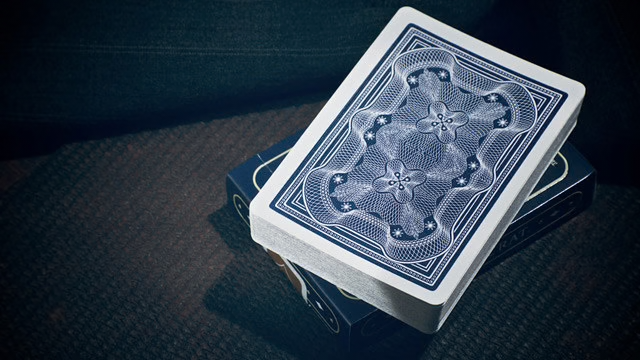The story of Aristocrat playing cards is a fascinating journey through American card manufacturing history, spanning over a century of evolution from bank note artistry to modern collector favorites. These elegant cards represent one of the most distinguished brands in the playing card world, with roots that trace back to the intricate craftsmanship of currency engravers.
Origins in Bank Note Artistry (1908-1914)
The Aristocrat legacy begins with the American Bank Note Company, a prestigious firm established in 1795 that specialized in producing national currency, finely engraved stock certificates, and security printing including postage stamps. Around 1908, this established currency printing company decided to venture into the playing card market, bringing their expertise in intricate scrollwork and detailed engraving to card design.
The American Bank Note Company's playing cards featured the distinctive "bank note" back design—ornate scrollwork patterns that closely resembled the sophisticated engravings found on U.S. currency. These designs were created using the same techniques and artistic sensibilities that made American banknotes so difficult to counterfeit. However, the company encountered significant production challenges. Their cards lacked the standard opaque black paste liner between paper layers, making them translucent when held to bright light—a serious flaw for card games.
The Russell Playing Card Company Era (1914-1929)
Willis W. Russell had established his modest playing card business in Milltown, New Jersey, in 1905, initially producing various brands including Recruits, Regents, Rustlers, and Blue Ribbon cards. However, Russell's company faced financial difficulties and ceased operations in 1911, only to be salvaged by Benjamin Rosenthal who merged it with the Kalamazoo Playing Card Company to form the Russell Playing Card Company.
In 1914, the Russell Playing Card Company made a pivotal acquisition—purchasing the American Bank Note Company's playing card division. This acquisition brought the intricate bank note designs under Russell's control, and production of these elegant cards continued at Russell's Milltown, New Jersey plant. The Aristocrat brand was officially introduced around 1915, featuring the beautiful scrollwork designs that had originated with American Bank Note.
Russell's version of the Aristocrat cards maintained the superior quality and intricate detail of the original bank note designs. The company produced multiple variations of the bank note back design, with the most popular being Back No. 1, which would survive into modern times. These cards were printed on higher quality stock with improved opacity, solving the transparency issues that had plagued the American Bank Note Company's original production.
USPCC Acquisition and Golden Age (1929-1980s)
In 1929, the Russell Playing Card Company was acquired by the United States Playing Card Company (USPCC), bringing the Aristocrat brand into the prestigious USPCC lineup alongside established favorites like Bicycle, Bee, and Tally-Ho. This acquisition marked the beginning of Aristocrat's golden age as a premium playing card brand.
Under USPCC ownership, Aristocrat cards became renowned for their superior quality and distinctive features. They were printed on premium card stock with a linen finish, making them highly favored by magicians and professional card rooms for their durability and exceptional handling characteristics. The bank note back design remained popular not only for its aesthetic appeal but also for its resemblance to U.S. currency designs, which added an element of sophistication to card games.
USPCC produced special casino versions of Aristocrat cards, including the "Club Special" edition. These borderless versions allowed casinos to have their logos printed directly on the card backs, making them popular in gambling establishments. The cards' premium quality and professional appearance made them a favorite choice for serious card players and gambling venues.
Throughout this period, Aristocrat cards featured custom colorations on the court cards and carefully adjusted color intensities that distinguished them from standard Bicycle cards. The attention to detail extended to the packaging, with elegant tuck boxes featuring embossed elements and gold accents that conveyed the regal quality associated with the Aristocrat name.
The Hiatus and Modern Revival (1980s-Present)
Aristocrat cards ceased retail production in the mid-1980s, though they continued to be manufactured for casino use. For nearly three decades, these elegant cards were unavailable to collectors and enthusiasts, making vintage Aristocrat decks increasingly sought after in the collecting community.
The brand experienced a significant revival in 2011 when USPCC reintroduced Aristocrat cards to the retail market. This modern reproduction maintained the classic Bank Note Back No. 1 design but featured updated elements. Most notably, USPCC replaced the "R" for Russell in the center of the ace of spades design, marking the transition from the historical Russell branding to full USPCC identity.
The 2017 relaunch brought Aristocrat cards back as a premium retail brand, featuring the same high-quality stock and linen finish that had made them famous. Modern Aristocrat decks include special features such as blank face cards and maintain the traditional numbering system (727) that had been associated with the brand since the Russell era.
Legacy and Collecting Appeal
Today, Aristocrat playing cards represent a unique bridge between historical American craftsmanship and modern card manufacturing excellence. Vintage decks from the Russell and early USPCC eras are highly prized by collectors, particularly those with the original Russell ace of spades or intact tax stamps. The transition years of the early 1940s, when branding changed from Russell Playing Card Co. to U.S. Playing Card Co., are especially significant to collectors.
The modern Aristocrat cards continue to attract both magicians and collectors who appreciate their superior handling characteristics and historical significance. The bank note design remains as striking today as it was over a century ago, serving as a testament to the enduring appeal of fine craftsmanship in playing card design.
The complete history of Aristocrat playing cards demonstrates how a single design concept—translating the artistry of currency engraving to playing cards—could create a brand that has survived ownership changes, production hiatuses, and changing market conditions to remain relevant for modern card enthusiasts. From the original American Bank Note Company's venture into card manufacturing to today's premium USPCC production, Aristocrat cards continue to represent the pinnacle of American playing card craftsmanship.

